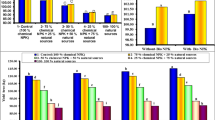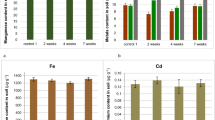Abstract
LIME-INDUCED chlorosis of fruit trees is a serious problem on calcareous soils in Great Britain, and until recently the only practical means of correcting this disorder was a combination of grass cover and trunk injection of iron salts. The injection method is laborious, transient in effect and often causes severe damage to the trunk, especially to Prunus species. Soil treatment with iron salts has not been effective owing to precipitation of iron in the soil.
This is a preview of subscription content, access via your institution
Access options
Subscribe to this journal
Receive 51 print issues and online access
$199.00 per year
only $3.90 per issue
Buy this article
- Purchase on Springer Link
- Instant access to full article PDF
Prices may be subject to local taxes which are calculated during checkout
Similar content being viewed by others
References
Jacobson, L., Plant Physiol., 26, 411 (1951).
Stewart, I., and Leonard, C. D., Citrus Mag., 14, 22 (1952).
Leonard, C. D., and Stewart, I., Proc. Amer. Soc. Hort. Sci., 62, 103 (1953).
Chaberek, S., and Bersworth, F. C., Science, 118, 280 (1953).
Wallace, A., North, C. P., Kofranek, A. M., and Lunt, O. R., Calif. Agric., 6, 13 (1953).
Bould, C., Ann. Rep. Long Ashton Res. Sta. 1953, p. 91.
Author information
Authors and Affiliations
Rights and permissions
About this article
Cite this article
BOULD, C. Chelated Iron Compounds for the Correction of Lime-induced Chlorosis in Fruit. Nature 175, 90–91 (1955). https://doi.org/10.1038/175090a0
Issue Date:
DOI: https://doi.org/10.1038/175090a0
This article is cited by
-
Lime-induced iron chlorosis in sugarcane
Fertilizer Research (1988)
-
Physiology of foliar uptake of inorganic nutrients
Proceedings / Indian Academy of Sciences (1986)
-
Behaviour of iron chelates in calcareous soils
Plant and Soil (1957)
Comments
By submitting a comment you agree to abide by our Terms and Community Guidelines. If you find something abusive or that does not comply with our terms or guidelines please flag it as inappropriate.



